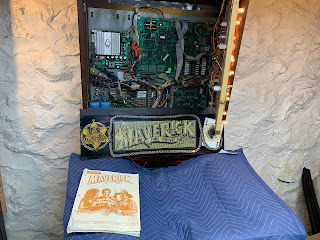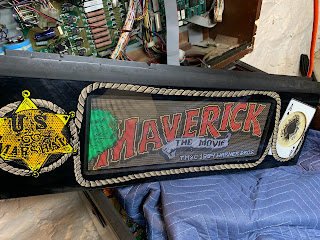Chips and Boards (mostly not OK!)
So, after mucking around with the CPU, I'm looking at the power supply. The previous owner of this machine doesn't know how capacitors work.
It turns out, that almost half the values of the capacitors on this power supply were the wrong value. Perhaps that's the source of lots of my problems. I ordered a kit from someone on pinside.com (it's easier than farting around on Digikey), and replaced the capacitors. Someone had been there before me, and pulled up a pad or two. I worked around that by running the leads where the traces weren't.
(The eagle eyed among you might notice that not all the mounting screws are in place. That seems to be a common problem in my machine – not enough connections to ground. I'm ordering a bunch of screws from McMasterCarr to fix this.)
Putting the power supply back in place, and turning on just the power supply has all the test points registering voltages at what I consider "in range". That's good. As I slowly plugged in connectors and powered on the machine, I found that plugging in the playfield solenoids causes the "lazer kicker" to fire. But, that's controlled by the CPU (which is NOT currently powered). Looking at the circuit, it looks like the "lazer kicker" and the "vertical kicker" are CPU controlled, and the vertical kicker isn't firing. I haven't tracked it down too far, but right now I think it might be a PIA chip (they notoriously go bad), or something else between the CPU board and the kicker. Another interesting problem to debug…
What's that sound?
My sound board has been unreliable. It'll play music… sometimes. Also, there's a hum. I figured part was related to the power supply, and part was related to the grounding straps that have been cut between the back cabinet and the playfield cabinet (is there a better word for that part?). Reading online, it looks like sound hums are very common in DataEast/Sega games, and most people have solved their problem by isolating the sound board from the back cabinet's ground plane. A quick trip to my local TrueValue hooked me up with the nylon screws, and testing for continuity on the sound board with ground (and nothing plugged in) tells me my sound board is now floating WRT the ground plane. But, while I had the board out, I took a look at the back of the board, and, "holy not enough solder, Batman."
I've marked some of the joints that don't really have a lot of solder to make me feel comfortable. So, I touched up the board, and connectors. If you look at the all the shiny places in the next picture, you'll see how widespread the lack of solder was:
I'll see how this all works out tonight as I plug away again. I hope the next post will say this is all working, and I'll describe something else I'm 3D modeling, but we'll see…






Comments
Post a Comment